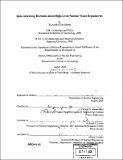Risk-informing decisions about high-level nuclear waste repositories
Author(s)
Ghosh, Suchandra Tina, 1973-
DownloadFull printable version (7.841Mb)
Other Contributors
Massachusetts Institute of Technology. Dept. of Nuclear Engineering.
Advisor
George E. Apostolakis.
Terms of use
Metadata
Show full item recordAbstract
Performance assessments (PAs) are important sources of information for societal decisions in high-level radioactive waste (HLW) management, particularly in evaluating safety cases for proposed HLW repository development. Assessing risk from geologic repositories for HLW poses a significant challenge due to the uncertainties in modeling complex systems of such large temporal and spatial scales. Because of the extensive uncertainties, a typical safety case for a proposed HLW repository is comprised of PA results coupled with various defense-in-depth elements, such as the multi-barrier requirement for repository design, and insights from supplementary analyses. This thesis proposes an additional supplementary analysis, the Strategic Partitioning of Assumption Ranges and Consequences (SPARC), that could be used: (1) in a safety case to help build confidence in a repository system, (2) to provide risk information for decisions on how to allocate resources for future research, and (3) to provide risk information for stakeholder deliberation. (cont.) The SPARC method extracts risk information from existing PAs and supporting databases by uncovering what sets of model parameter values taken together could result in a substantially-increased-dose (SID) from the repository, and displays the results in SPARC trees. The SPARC method is applied to the proposed Yucca Mountain HLW repository (YMR), as a demonstrative example. The YMR is a particularly interesting example since there have been many public disagreements about it from the inception of the project. This thesis demonstrates how risk information could be extracted from existing PAs for the YMR, with particular attention to addressing the concerns raised by stakeholders. Preliminary application of the SPARC method to the YMR shows that it yields interesting insights into 'savior' attributes of the repository, i.e., those parameter assumption ranges that, if true, are projected to prevent SIDs to different dose receptors (at 10-km or 20-km from the repository, for different future time periods) with very high probability. The thesis also explores how the SPARC method could contribute to other confidence-building exercises, such as assessing repository barrier capability and prioritizing future research efforts.
Description
Thesis (Ph. D.)--Massachusetts Institute of Technology, Dept. of Nuclear Engineering, 2004. Includes bibliographical references (p. 129-137).
Date issued
2004Department
Massachusetts Institute of Technology. Department of Nuclear Engineering; Massachusetts Institute of Technology. Department of Nuclear Science and EngineeringPublisher
Massachusetts Institute of Technology
Keywords
Nuclear Engineering.